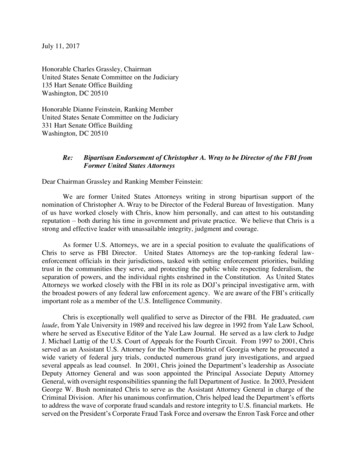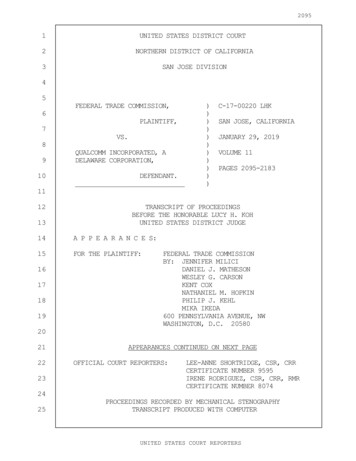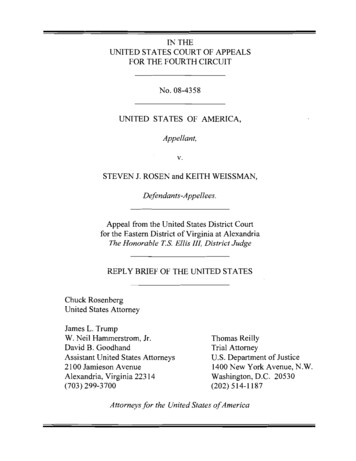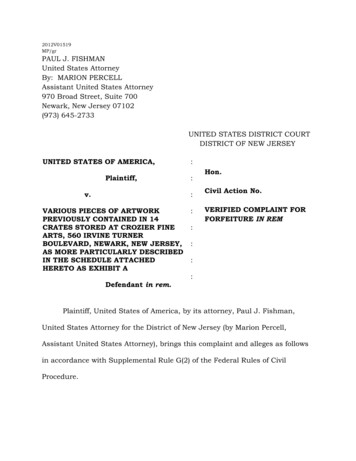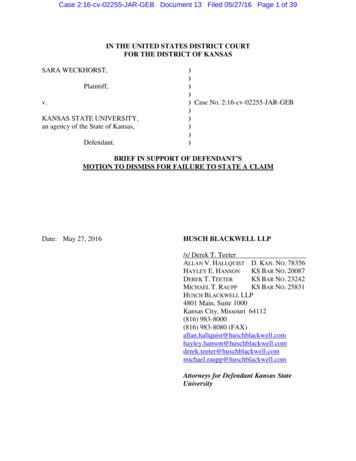
Transcription
Case 2:16-cv-02255-JAR-GEB Document 13 Filed 05/27/16 Page 1 of 39IN THE UNITED STATES DISTRICT COURTFOR THE DISTRICT OF KANSASSARA WECKHORST,Plaintiff,v.KANSAS STATE UNIVERSITY,an agency of the State of Kansas,Defendant.))))) Case No. 2:16-cv-02255-JAR-GEB)))))BRIEF IN SUPPORT OF DEFENDANT’SMOTION TO DISMISS FOR FAILURE TO STATE A CLAIMDate: May 27, 2016HUSCH BLACKWELL LLP/s/ Derek T. TeeterALLAN V. HALLQUIST D. KAN. NO. 78356HAYLEY E. HANSONKS BAR NO. 20087DEREK T. TEETERKS BAR NO. 23242MICHAEL T. RAUPPKS BAR NO. 25831HUSCH BLACKWELL LLP4801 Main, Suite 1000Kansas City, Missouri 64112(816) 983-8000(816) 983-8080 ommichael.raupp@huschblackwell.comAttorneys for Defendant Kansas StateUniversity
Case 2:16-cv-02255-JAR-GEB Document 13 Filed 05/27/16 Page 2 of 39TABLE OF CONTENTSPageTABLE OF AUTHORITIES . iiiI.INTRODUCTION/NATURE OF THE MATTER . 1II.STATEMENT OF FACTS . 3III.QUESTIONS PRESENTED. 4IV.ARGUMENT . 5A.Ms. Weckhorst Fails To State A Claim For A Violation Of Title IX. 51.Activities off campus and at private parties are not an “educationprogram or activity” of K-State. . 72.Ms. Weckhorst fails to allege a viable Title IX claim based on KState’s response to prior reports of sexual harassment . 123.B.C.a.K-State did not have actual knowledge of the alleged priorharassment . 12b.Ms. Weckhorst does not sufficiently plead that any allegeddeliberate indifference by K-State regarding allegations ofprior sexual assaults caused her alleged rapes . 16Ms. Weckhorst fails to allege a viable Title IX claim because shedoes not plead that K-State’s alleged deliberate indifference to herreports caused further harassment after the alleged rapes . 17Ms. Weckhorst Fails To State A Claim For Violation Of The KCPA . 191.Ms. Weckhorst fails to plead her KCPA claim with particularity . 192.Ms. Weckhorst fails to allege that she was “aggrieved” by anmisrepresentation . 23Ms. Weckhorst Fails To State A Claim For Negligence . 241.K-State cannot be liable for negligence because there is no legalduty to protect Ms. Weckhorst from the alleged criminal acts ofthird-parties occurring off campus . 252.K-State is immune from liability under several of the KTCA’sexceptions to liability . 27a.Enforcement or failure to enforce a law . 27i
Case 2:16-cv-02255-JAR-GEB Document 13 Filed 05/27/16 Page 3 of 39b.V.Discretionary functions . 28CONCLUSION . 30CERTIFICATE OF SERVICE . 31ii
Case 2:16-cv-02255-JAR-GEB Document 13 Filed 05/27/16 Page 4 of 39TABLE OF AUTHORITIESPageFederal Court CasesAshcroft v. Iqbal,556 U.S. 662 (2009) . 5Bell Atl. Corp. v. Twombly,550 U.S. 544, 570 (2007) . 5, 16Bradshaw v. Rawlings,612 F.2d 135 (3d Cir. 1979) . 26Burton v. R.J. Reynolds Tobacco Co.,884 F. Supp. 1515 (D. Kan. 1995) . 19C.R.K. v. U.S.D.176 F. Supp. 2d 1145, 1153 (D. Kan. 2001) . 11Canadian St. Regis Bank of Mohawk Indians v. New York,2013 WL 3992830 (N.D. N.Y. 2013) . 15Chevron, U.S.A., Inc. v. Natural Res. Def. Council, Inc.,467 U.S. 837 (1984) . 12Citizens for Peace in Space v. City of Colorado Springs,477 F.3d 1212 (10th Cir. 2007) . 3Clifford v. Regents of Univ. of California,No. 2:11-CV-02935-JAM, 2012 WL 1565702 (E.D. Cal. Apr. 30, 2012) . 9Davis Next Friend LaShonda D. v. Monroe Cty. Bd. of Educ.,526 U.S. 629 (1999) . 6, 8, 9, 10, 11, 12, 19Denius v. Dunlap,330 F.3d 919 (7th Cir. 2003) . 15Doe v. Bibb Cnty. Sch. Dist.,126 F. Supp. 3d 1366 (M.D. Ga. 2015) . 18Doe v. Bibb Cty. Sch. Dist.,83 F. Supp. 3d 1300 (M.D. Ga. 2015) . 15Doe v. Blackburn Coll.,No. 06-3205, 2012 WL 640046 (C.D. Ill. Feb. 27, 2012) . 14iii
Case 2:16-cv-02255-JAR-GEB Document 13 Filed 05/27/16 Page 5 of 39Doe v. Columbia Univ.,101 F. Supp. 3d 356 (S.D.N.Y. 2015) . 17, 18Escue v. N. Okla. College,450 F.3d 1146 (10th Cir. 2006) . 7, 13, 17, 18Foster v. Raspberry,652 F. Supp. 2d 1342 (M.D. Ga. 2009) . 29Gomes v. Univ. of Maine Sys.,304 F. Supp. 2d 117 (D. Me. 2004) . 29Grynberg v. Koch Gateway Pipeline Co.,390 F.3d 1276 (10th Cir. 2004) . 15In re Univ, Serv. Fund Telephone Billing Practices Lit.,300 F. Supp. 2d 1107 (D. Kan. 2003) . 19Jamieson v. Vatterott Educational Center, Inc.,473 F. Supp. 2d 1153 (D. Kan. 2007) . 20, 21, 22Kenney v. Citimortgage, Inc.,No. 14-2436-JAR, 2015 WL 1957880 (D. Kan. Apr. 29, 2015) . 5Khalik v. United Air Lines,671 F.3d 1188 (10th Cir. 2012) . 5Mattos v. Eli Lilly & Co.,No. 12-1014-JWL, 2012 WL 1893551 (D. Kan. May 23, 2012) . 22Ostrander v. Duggan,341 F.3d 745 (8th Cir. 2003) . 8, 9Ridge at Red Hawk, L.L.C. v. Schneider,493 F.3d 1174 (10th Cir. 2007) . 5Rinehart v. Saint Luke’s S. Hosp., Inc.,No. 10-2209-SAC, 2011 WL 3348234 (D. Kan. Aug. 3, 2011) . 23Robbins v. Oklahoma,519 F.3d 1242 (10th Cir. 2008) . 5Roe v. St. Louis University,746 F.3d 874 (8th Cir. 2014) . 9, 10Rost ex rel. K.C. v. Steamboat Springs RE-2 Sch. Dist.,511 F.3d 1114 (10th Cir. 2008) . 6, 7, 10, 13, 18iv
Case 2:16-cv-02255-JAR-GEB Document 13 Filed 05/27/16 Page 6 of 39Rouse v. Duke Univ.,914 F. Supp. 2d 717 (M.D.N.C. 2012) . 18, 19Samuelson v. Oregon State Univ.,No. 6:15-CV-01648-MC, 2016 WL 727162 (D. Or. Feb. 22, 2016) . 9, 10Schaefer v. Las Cruces Pub. Sch. Dist.,716 F. Supp. 2d 1052 (D.N.M. 2010) . 14Smallwood v. Foos,No. 07-cv-02652-WYD-MEH, 2008 WL 3338374 (D. Colo. 2008) . 15T.Z. v. City of New York,635 F. Supp. 2d 152 (E.D.N.Y.), rev’d in part on reconsideration on other grounds,634 F. Supp. 2d 263 (E.D.N.Y. 2009) . 14Thompson v. Jiffy Lube Int’l, Inc.,505 F. Supp. 2d 907 (D. Kan. 2007) . 19Townsend v. Swank,404 U.S. 282 (1971) . 12, 13State Court CasesAdams v. Bd. of Sedgwick Cty. Comm’rs,214 P.3d 1173 (Kan. 2009) . 25, 27Baldwin v. Zoradi,123 Cal. App. 3d 275, 176 Cal. Rptr. 809 (1981) . 26Barber v. Williams,767 P.2d 1284 (Kan. 1989) . 28Beebe v. Fraktman,921 P.2d 216 (Kan. Ct. App. 1996) . 28Burney v. Kansas Dep’t of Soc. & Rehab. Servs.,931 P.2d 26 (Kan. Ct. App. 1997) . 29Crow v. State of California,222 Cal. App. 3d 192, 271 Cal. Rptr. 349 (1990) . 26Eiseman v. State of New York,70 N.Y.2d 175, 518 N.Y.S.2d 608, 511 N.E.2d 1128 (1987) . 26Finstad v. Washburn Univ. of Topeka,845 P.2d 685 (Kan. 1993) . 23v
Case 2:16-cv-02255-JAR-GEB Document 13 Filed 05/27/16 Page 7 of 39G. v. State Dept. of SRS,833 P.2d 979 (Kan. 1992) . 28Gragg v. Wichita State Univ.,934 P. 2d 121 (Kan. 1997) . 26Hesler v. Osawatomie State Hospital,971 P.2d 1169 (Kan. 1999) . 25Kansas State Bank & Tr. Co. v. Specialized Transp. Servs., Inc.,819 P.2d 587 (Kan. 1991) . 25Nero v. Kansas State Univ.,861 P.2d 768 (Kan. 1993) . 25, 26Tanja H. v. Regents,228 Cal. App. 3d 434, 278 Cal .Rptr. 918 (1991) . 26Thies v. Cooper,753 P.2d 1280 (Kan. 1988) . 25, 26Yeasin v. Univ. of Kan.,360 P.3d 423 (Kan. Ct. App. 2015) . 10, 11Federal Statutory Authorities20 U.S.C. § 1092(f)(1)(F) . 1420 U.S.C. § 1681(a) . 5, 720 U.S.C. 1687 . 728 U.S.C. § 2680(a) . 28Statutory AuthoritiesK.S.A. §§ 50-634 . 23K.S.A. 75-6103(a) . 24K.S.A. 75-6104(a) . 27K.S.A. 75-6104(c) . 27K.S.A. 75-6104(e) . 27vi
Case 2:16-cv-02255-JAR-GEB Document 13 Filed 05/27/16 Page 8 of 39Federal Rules and Regulations34 C.F.R. § 106.31(a) . 7Fed. R. Civ. P. 9(b). 19Legislative MaterialsExamining the Use of Agency Regulatory Guidance: Hearing Before the Subcomm. OnRegulatory Affairs and Fed. Management of the S. Comm. On Homeland Security andGovernmental Affairs, 114th Cong. 18 (2015), available 2015 -final-printed-hearingrecord . 11Additional AuthoritiesED’s Revised Sexual Harassment Guidance at 2 (ED, 2001), available hguide.pdf . a.aspx. . hguide.pdf . tml . 18Sofi Sinozich & Lynn Langton, Rape and Sexual Assault Victimization Among CollegeAge Females, 1995-2013, U.S. Dept. of Justice, Bureau of Justice Statistics, at 1 (Dec.2014), available at http://www.bjs.gov/content/pub/pdf/rsavcaf9513.pdf . 16vii
Case 2:16-cv-02255-JAR-GEB Document 13 Filed 05/27/16 Page 9 of 39I.INTRODUCTION/NATURE OF THE MATTERPlaintiff Sara Weckhorst attempts to hold Kansas State University (“K-State”) liable forrapes allegedly committed by two male K-State students J.F. and J.G. These alleged rapesoccurred in the context of private parties, located off campus, on property not owned by K-State.The first occurred at an area approximately ten miles from K-State’s campus in rural RileyCounty, and the subsequent alleged rapes occurred at a fraternity house that is privately ownedand also not part of K-State’s campus. Yet, rather than suing her rapists or the fraternity wherethe second alleged rape occurred, Ms. Weckhorst has instead sued K-State, contending it shouldbe civilly liable for failing to prevent or respond to these alleged third-party criminal acts. All ofher theories are flawed, and this Court should dismiss them for failure to state a claim under Rule12(b)(6).First, Ms. Weckhorst asserts that K-State violated Title IX of the Higher Education Act.Even if everything Ms. Weckhorst alleges is true, K-State did not violate Title IX because Ms.Weckhorst does not plead the existence of sexual harassment occurring in any of K-State’seducation programs or activities (or, in other words, under its operations) such that K-State hadsubstantial control over J.F., J.G., and the context in which the alleged rapes occurred. And evenif K-State did violate Title IX, Ms. Weckhorst fails to plead facts establishing the elements of thenarrow private right of action under Title IX created by the Supreme Court, which requires,among other things, that K-State have been deliberately indifferent to known sexual harassment.Here, Ms. Weckhorst fails to sufficiently plead that K-State had actual knowledge of sexualharassment posing a substantial risk to Ms. Weckhorst that predated the alleged rapes or that KState’s alleged deliberate indifference to her report of the rapes caused her to suffer furthersexual harassment—a strict requirement under Tenth Circuit precedent. Thus, her Title IX claim
Case 2:16-cv-02255-JAR-GEB Document 13 Filed 05/27/16 Page 10 of 39fails.Second, Ms. Weckhorst fails to plead her claims that K-State violated the KansasConsumer Protection Act (“KCPA”) with specificity, as required under Rule 9(b); Ms.Weckhorst fails to plead the “who, what, when, and where” of the alleged misrepresentationsabout the “safety” of local fraternities. Additionally, and regardless of her failure to meet Rule9(b), Ms. Weckhorst does not allege that she was “aggrieved” by any of the allegedmisrepresentations, which is a key element of a private claim under the KCPA. Thus, her KCPAclaim fails under controlling Kansas Supreme Court precedent.Third, and finally, Ms. Weckhorst’s negligence claim fails because K-State does not owea legal duty to Ms. Weckhorst to prevent the criminal acts of third-parties occurring off campus.Ms. Weckhorst does not plead any facts that support a legal theory that would give rise to such aduty. Moreover, even if she could, her claim is barred by sovereign immunity as it falls underthe exceptions to liability enumerated in the Kansas Tort Claims Act (“KTCA”).Thus, as described more fully below, Ms. Weckhorst fails to state any viable claim forrelief against K-State, and the Court should dismiss her Complaint entirely. This does not mean,however, that Ms. Weckhorst is without recourse.Ms. Weckhorst can sue the alleged rapistsfor, at a minimum, the intentional tort of battery, and she could presumably bring a claim againstthe owner(s) of the properties where the alleged rapes occurred for premises-liability. She mightalso sue the local fraternity chapter and national chapter for negligence if she believes fraternityactions or inactions caused her assaults. But suing K-State on flawed and unsupported legaltheories, as she has done here, is simply not the proper vehicle for Ms. Weckhorst to obtainrecourse for her alleged injuries.2
Case 2:16-cv-02255-JAR-GEB Document 13 Filed 05/27/16 Page 11 of 39II.STATEMENT OF FACTSMs. Weckhorst alleges that, when she was a freshman at K-State, she attended a party at“Pillsbury Crossing.” Compl. ¶ 13. Pillsbury Crossing is located outside the City of Manhattan,in Rural Riley County, Kansas, on the Deep Creek.See Ex. A, Printout from GoogleMaps/Pedometer. 1 Pillsbury Crossing is approximately ten miles from the middle of K-State’scampus. Id.Ms. Weckhorst alleges that she “consum[ed] a large amount of alcohol and blacked out.”Compl. ¶ 13. Ms. Weckhorst claims that J.F. took her into his truck and raped her in front ofsome fifteen students, several of whom she alleges took videos and photographs of the rape. Id.Ms. Weckhorst alleges that J.F. then transported her to a fraternity house located off KState’s campus and took her to a bed in the house. Id. ¶¶ 14-15. She asserts that J.F.“assaulted” her on the drive and raped her again on the bed. Id. Ms. Weckhorst alleges that,when she then awoke “from blackout” hours later, she was being raped by J.G. Id. ¶ 16. Shealleges that, while she was awake but still “very intoxicated and confused,” J.G. raped her againon a patio at the fraternity house. Id. Ms. Weckhorst states that she reported the rapes to theRiley County Police. Id. ¶ 32. Despite her allegation that fifteen witnesses observed the firstalleged rape and that some took video and photographs, she does not allege that law enforcementor prosecutors have taken action against J.F. or J.G. 2Nearly two years after the alleged rapes, Ms. Weckhorst filed the present lawsuit onlyagainst K-State, alleging that K-State is responsible, and should pay her compensatory damages,1See Citizens for Peace in Space v. City of Colorado Springs, 477 F.3d 1212, 1218 (10th Cir. 2007) (noting thatcourts may take judicial notice of distance and taking judicial notice of distance reflected on GoogleMaps/Pedometer).2Though J.F. and J.G. are not presently parties to this case, K-State seeks their joinder as necessary parties underRule 19(a) and, if they are unable to be joined, dismissal of the case pursuant to Rule 19(b) and Rule 12(b)(7).3
Case 2:16-cv-02255-JAR-GEB Document 13 Filed 05/27/16 Page 12 of 39because it did not investigate the alleged rapes after the fact and because K-State was supposedlyaware that local fraternities pose a high risk of sexual assault. Id. ¶¶ 4, 50-52.Ms. Weckhorst seeks compensatory damages, civil penalties, attorneys’ fees, adeclaratory judgment, and injunctive relief through the following three counts: (1) violation ofTitle IX for “Deliberate Indifference to Plaintiff’s Report of Rapes”; (2) violation of the KansasConsumer Protection Act; and (3) negligence. All three counts fail to state a claim upon whichrelief can be granted. As such, this Court should dismiss Ms. Weckhorst’s Complaint in itsentirety.III.QUESTIONS PRESENTED1.Whether Ms. Weckhorst fails to state a claim for a violation of Title IX where thealleged rapes did not occur in the context of any education program or activity ofK-State and, thus, where K-State lacked “substantial control” over both thealleged rapists and the context in which the alleged rapes occurred?2.Whether Ms. Weckhorst fails to state a claim for a violation of Title IX based onK-State’s alleged deliberate indifference to sexual harassment of others predatingMs. Weckhorst’s alleged rapes where K-State lacked “actual knowledge” of anysubstantial risk to Ms. Weckhorst?3.Whether Ms. Weckhorst fails to state a claim for a violation of Title IX for KState’s alleged deliberate indifference in responding to Ms. Weckhorst’s reportsof rape where Ms. Weckhorst does not allege K-State’s actions caused her tosuffer further sexual harassment in its education programs or activities?4.Whether Ms. Weckhorst fails to plead her KCPA claim with the specificityrequired by Rule 9(b) and whether she sufficiently alleges that she was“aggrieved” by K-State’s alleged misrepresentations about the safety offraternities?5.Whether Ms. Weckhorst’s claim for negligence fails because she does not plead a“special relationship” with K-State such that K-State would have a legal duty toprotect her from alleged wrongful and criminal conduct of third-parties occurringoff campus on private property?6.Whether K-State is immune to Ms. Weckhorst’s negligence claims under theimmunity provisions of the KTCA?4
Case 2:16-cv-02255-JAR-GEB Document 13 Filed 05/27/16 Page 13 of 39IV.ARGUMENT“[A] complaint must present factual allegations, assumed to be true, that ‘raise a right torelief above the speculative level,’ and must contain ‘enough facts to state a claim to relief that isplausible on its face.’” Kenney v. Citimortgage, Inc., No. 14-2436-JAR, 2015 WL 1957880, at*1 (D. Kan. Apr. 29, 2015) (quoting Bell Atl. Corp. v. Twombly, 550 U.S. 544, 555, 570 (2007)).“Under this standard, ‘the mere metaphysical possibility that some plaintiff could prove some setof facts in support of the pleaded claims is insufficient; the complaint must give the court reasonto believe that this plaintiff has a reasonable likelihood of mustering factual support for theseclaims.’” Id. (quoting Ridge at Red Hawk, L.L.C. v. Schneider, 493 F.3d 1174, 1177 (10th Cir.2007)).“While the 12(b)(6) standard does not require that Plaintiff establish a prima facie case in[her] complaint, the elements of each alleged cause of action help to determine whether Plaintiffhas set forth a plausible claim.” Khalik v. United Air Lines, 671 F.3d 1188, 1192 (10th Cir.2012)). “The allegations must be enough that, if assumed to be true, the plaintiff plausibly (notjust speculatively) has a claim for relief.” Id. (Robbins v. Oklahoma, 519 F.3d 1242, 1247-48(10th Cir. 2008)).“As the Supreme Court explained, ‘[a] pleading that offers labels andconclusions or a formulaic recitation of the elements of a cause of action will not do. Nor does acomplaint suffice if it tenders naked assertion[s] devoid of further factual enhancement.’” Id.(quoting Ashcroft v. Iqbal, 556 U.S. 662, 678 (2009)).A.Ms. Weckhorst Fails To State A Claim For A Violation Of Title IXTitle IX provides: “No person in the United States shall, on the basis of sex, be excludedfrom participation in, be denied the benefits of, or be subjected to discrimination under anyeducation program or activity receiving Federal financial assistance.” 20 U.S.C. § 1681(a).5
Case 2:16-cv-02255-JAR-GEB Document 13 Filed 05/27/16 Page 14 of 39Thus, the statute only applies to entities that receive federal financial assistance. Davis NextFriend LaShonda D. v. Monroe Cty. Bd. of Educ., 526 U.S. 629, 641 (1999). And it does notpurport to directly regulate conduct between third parties such as students. Id. at 640-41.Rather, Title IX simply requires that an institution reasonably respond to discriminatory thirdparty sexual harassment occurring within its education programs and activities. Id. at 645.Although the statute does not expressly create a private right of action, the SupremeCourt has held that one exists in very limited situations if an institution is “deliberatelyindifferent” to student-on-student sexual harassment. Id. Specifically, an institution may becivilly liable in a case of student-on-student sexual harassment only if it “(1) has actualknowledge of, and (2) is deliberately indifferent to, (3) harassment that is so severe, pervasiveand objectively offensive as to (4) deprive access to the educational benefits or opportunitiesprovided by the school.” Rost ex rel. K.C. v. Steamboat Springs RE-2 Sch. Dist., 511 F.3d 1114,1119 (10th Cir. 2008). Further, an institution can be liable only in situations where the sexualharassment occurs within its education programs and activities because these are the onlycircumstances where the institution “exercises substantial control over both the harasser and thecontext in which the known harassment occurs.” Davis, 526 U.S. at 645. “Only then can therecipient be said to ‘expose’ its students to harassment or ‘cause’ them to undergo it ‘under’ therecipient’s programs” in such a way as to cause sex discrimination. Id.The Tenth Circuit has required strict enforcement of the causation requirement.Steamboat Springs, 511 F.3d at 1123 (imposing strict requirement that institution’s deliberateindifference must cause “further sexual harassment”). Thus, the plaintiff must establish that theinstitution’s deliberate indifference caused further harassment. Id. And that is the case whetherthe Title IX claim is based on alleged deliberate indifference to sexual harassment of others6
Case 2:16-cv-02255-JAR-GEB Document 13 Filed 05/27/16 Page 15 of 39before an attack that makes a plaintiff more vulnerable to the attack or alleged deliberateindifference after an attack that causes a plaintiff to endure additional harassment. Id. at 1123.An institution’s mere failure to remediate the effects of sexual harassment, without more, doesnot give rise to Title IX liability. Id; Escue v. N. Okla. College, 450 F.3d 1146, 1155 (10th Cir.2006) (granting summary judgment where plaintiff failed to establish that the institution’sresponse was “ineffective such that she was further harassed”).Here, although Ms. Weckhorst appears to frame her cause of action as based on K-State’sresponse to her allegations of sexual harassment in the form of rape (e.g., by titling her Title IXcause of action “Deliberate Indifference to Plaintiff’s Report of Rapes”), her Complaint alsoincludes allegations about K-State’s response to alleged sexual harassment against others prior toMs. Weckhorst’s alleged rape. Thus, in an abundance of caution, K-State demonstrates belowthat both theories fail to state a claim.1.Activities off campus and at private parties are not an “education programor activity” of K-State.As discussed above, Title IX prohibits sex discrimination in K-State’s “educationprograms and activities.” 20 U.S.C. § 1681(a). The statute defines “program or activity” toinclude “all of the operations of . . . a college, university, or other postsecondary institution, or apublic system of higher education.” 20 U.S.C. 1687 (emphasis added). The Department ofEducation’s (“ED”) regulation reiterates this requirement. See 34 C.F.R. § 106.31(a) (explainingthat discrimination is disallowed “in any academic, extracurricular, research, occupationaltraining, or other education program or activity operated by a recipient which receives Federalfinancial assistance.”) (emphasis added).Thus, unless the sexua
IN THE UNITED STATES DISTRICT COURT. FOR THE DISTRICT OF KANSAS. SARA WECKHORST,) Plaintiff,) v.) Case No. 2:16-cv-02255-JAR-GEB KANSAS STATE UNIVERSITY, ) an agency of the State of Kansas,





